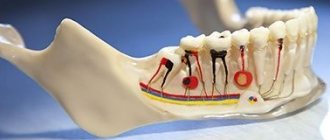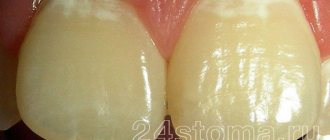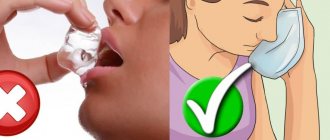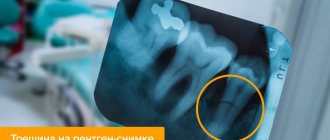Mechanical damage to a tooth due to injury without violating its integrity is called a bruise. This type of injury is common in children and adults, especially athletes. According to statistics, among all injuries to primary teeth, bruises account for 2.5%; bruises of permanent teeth account for 1.5% of the total number of traumatic injuries in the permanent dentition.
Even if the tooth looks unchanged after a bruise, it is necessary to visit a dentist to prevent the development of complications associated with the injury.
Symptoms
A strong blow to a tooth is accompanied by damage to periodontal tissue, and some fibers and small blood vessels rupture. There are no visible structural damage to the tooth; upon visual inspection, it appears intact. After a bruise, the tooth remains motionless, and minor mobility is rarely observed. The gums in the area of the injured tooth swell.
In the first hours after the impact, patients experience pain in the tooth, which intensifies when biting; the pain is aching in nature. The tooth feels high, and slight bleeding may occur from under the gum near it. When a bruise occurs, the neurovascular bundle of the tooth can be damaged, that is, the pulp is injured, and hemorrhage occurs in the pulp chamber, and the enamel becomes pink in color. A severe bruise can lead to the death of the pulp.
Often, when a bruise occurs, cracks appear on the tooth enamel, which can only be detected with a special examination.
So, factor #1 - caries
Caries occurs due to the destruction of tooth enamel
Destruction of enamel during caries, which occurs due to the activity of certain microbes that feed on organic compounds of tooth tissue. The enamel itself is very hard, and microorganisms simply cannot act on it.
But if a person himself creates favorable conditions for them, they begin to actively feed and reproduce. Microbes feel very comfortable in soft plaque, which can remain after not very thorough brushing or lack of proper hygiene. Bacteria feed on this plaque, releasing their waste products and acidifying the environment. Under such conditions, minerals leave the tooth and the enamel and dentin soften. This makes the organic part of the tooth tissue accessible to microbes and bacteria.
It should be noted that when drinking sweet soda, demineralization of teeth occurs faster, since this drink is a weak acid.
Typically, the process of demineralization of tooth enamel is noticeable and can be completely cured at an early stage, since tooth decay does not begin immediately.
In this regard, there are two types of treatment for caries
First, when caries is at the spot stage, remineralizing therapy is carried out. The enamel is saturated with lost minerals.
Or the affected area of enamel is sealed with a photopolymerizable resin (a technique called ICON).
In both cases, drilling the tooth is not required.
But if this moment is missed, then drilling of the tooth is required to remove the affected areas. And then a filling is placed,
overlay
or crown
depending on the degree of tooth decay.
Diagnostics
- Patients with a tooth injury are referred for x-ray diagnostics to exclude a root fracture. To obtain information using targeted radiography, it is sometimes necessary to take several images from different angles, which is undesirable for the patient.
The most accurate information about the condition of the roots is provided by computed tomography - an x-ray examination method that allows you to obtain a three-dimensional image of the tooth. The examination results are displayed on the computer screen and must be transferred to a CD or USB flash drive.
An X-ray examination of a tooth bruise reveals a slight widening of the periodontal fissure.
- The condition of the pulp after injury is monitored using EDI - electroodontodiagnosis. The method consists in determining the reaction of the nerve endings of the pulp to the influence of electric current. The level of electrical excitability of the pulp depends not only on its condition, but also on the degree of formation of the tooth root.
The examination is carried out 2 or 3 days after the injury, since on the first day the pulpal response may be reduced due to traumatic neuritis. Be sure to perform an electrical test on adjacent healthy teeth to compare sensitivity levels. 3-4 weeks after the injury, EDI is repeated.
- Another method of examination for a tooth bruise is transillumination, the essence of which is to pass a beam of cold light through the tooth and evaluate shadow formation. If there are cracks in the enamel after an impact, they will be clearly visible in the stream of light; The technique also helps to detect pulpitis. In modern clinics, all dental units are equipped with light guides for transillumination examination.
Is tooth sensitivity always associated with caries?
No not always. There can be several reasons for tooth sensitivity, and all of them are associated with thinning enamel. When dental nerves react to hot, sweet, sour, salty things that healthy teeth should not react to.
As you already know, the enamel becomes thinner or worn away due to the development of caries or strong mechanical stress.
Another increased sensitivity of the teeth occurs when the cervical area of the tooth is exposed, where the enamel is simply absent and the dentin begins to come into contact with everything that enters the mouth.
How to eliminate excessive tooth sensitivity
Treatment of tooth sensitivity occurs by eliminating the cause that causes it. This can be done surgically, therapeutically, or by installing a filling.
If the neck of the tooth is exposed, the gum is pulled over this place, and the operation is performed by a surgeon. Usually this manipulation is enough to solve the problem.
In the case of tooth wear, an integrated approach is necessary, since thinning of the enamel can also occur with excessively intensive tooth brushing. You should be especially careful when using electric toothbrushes; their strong impact can damage the gums, which leads to their receding.
Also, to eliminate the problem of abrasion, you may need the help of different specialists - an orthopedist, an orthodontist, in order to remove the incorrect pathological load on the teeth.
Treatment of mechanical damage or injury is carried out orthopedically - with the help of restoration or installation of crowns.
Complications after injury
With bruises, the prognosis is usually favorable, but in some cases the injury can lead to the following complications:
- Darkening of the enamel. After a bruise, the cause of darkening is hemorrhage into the pulp chamber: the pink color of the tooth darkens over time, the enamel acquires a brownish or gray tint. Depulped teeth tend to darken due to the fact that metabolic processes in them stop, the teeth become “dead”, and the enamel becomes dull.
- The death of the pulp leads to the development of pulpitis: the pulp decomposes, inflammation develops in the tooth, which without treatment turns into periodontitis.
- Periodontitis is inflammation of periodontal tissue. It can be: post-traumatic, occurring a short time after the injury; chronic, develop as a consequence of pulpitis. When a purulent infection occurs, there is a high risk of tooth loss and purulent blood poisoning.
- The appearance of a post-traumatic odontogenic cyst at the root apex during the development of post-traumatic periodontitis.
- Stopping the development of roots of permanent teeth in children.
- In case of injury to milk teeth, the following are possible: disruption of the formation of the rudiments of permanent teeth, their death.
Factor #2 - tooth wear
What does “accelerated” tooth wear look like?
Tooth wear is a decrease in the height of teeth due to physiological or pathological reasons.
Physiological wear is the natural wear and tear of teeth as a person chews while eating food. It is considered normal to wear off 1 mm of enamel by about 40 years of age.
Pathological abrasion is associated with various dental diseases, for example, malocclusion or bruxism. With pathological abrasion, several teeth become much shorter than the rest or loss of tooth enamel thickness occurs earlier, for example, at 20 years. In such cases, you should definitely consult a doctor.
Treatment
- For mild bruises, treatment consists of resting the tooth for 3-4 weeks by reducing the load during chewing: the menu includes soft and semi-liquid foods, and a blender is used to grind hard foods.
- To ensure rest for baby teeth, temporary bite separation with the help of mouth guards is used; if a permanent tooth is bruised, splinting is performed. The splint allows you to immobilize an injured tooth and redistribute the load during chewing onto healthy teeth.
- If the pulp dies due to an impact, the tooth cavity is opened and the pulp is removed, after which the root canals are filled and a permanent filling is installed. If the crown of a tooth darkens, it can be whitened.
- When a baby tooth is bruised, grinding of the cutting edge of the crown of the antagonist tooth is used to prevent tooth contact and reduce pain. This method is not used for permanent teeth.
- To relieve pain, it is recommended to take an anesthetic tablet (ibuprofen, ketorolac, nimesulide) and apply an anesthetic gel (Dentol, Kamistad) to the gums around the tooth.
- When swelling of the soft tissues of the face accompanies a bruise, cold compresses are applied: a plastic bottle with cold water (not lower than +4°C) is wrapped in a cloth and held on the area of swelling for 15-20 minutes.
- A course of magnetic laser therapy is carried out - a combined effect on injured tissue of a magnetic field and low-intensity laser radiation. The method helps improve healing processes, relieves swelling and inflammation. The course consists of 10 daily procedures lasting 5 minutes.
- UHF therapy is indicated to accelerate tissue regeneration.
Factor #3 - various dental injuries
What types of dental injuries are there?
Injuries occur due to blows, bruises, or attempts to bite off something hard.
The tooth simply breaks, but the nerve is not affected, then restoration of the hard tissue of the tooth is required.
There is also caries that does not go deep into the tooth and does not touch the nerve, but at the same time severely destroys the enamel, the pulp remains healthy.
In all three cases - caries, abrasion or injury, the doctor’s task is to restore the lost hard tissue of the tooth.
Methods for restoring hard tooth tissues
Methods for treating hard tissues depend on the degree of enamel destruction. There are special indices that allow the doctor to choose the optimal method of treatment, but the doctor’s experience and the accessibility and availability of materials also play an important role. For example, 10 years ago, many technologies were simply unavailable, and materials, let’s say, were not invented.
In case of minor damage, photopolymer composite filling materials are used; in a simple way, a filling is placed.
If there is greater destruction, then tooth restoration is used using a ceramic crown, which is made by a dental technician. That is, a crown or inlay is made in the laboratory and then placed in the required and previously prepared place.
When the tooth is severely damaged and there is nothing to attach the ceramic crown to, metal-ceramics or zirconium crowns are used:
Prevention
To prevent dental injuries, you must:
- Observe safety precautions at work, arrange the workplace and carry out potentially hazardous work in accordance with established rules.
- Properly equip playrooms for children and supervise children while playing.
- Follow traffic rules and use seat belts when traveling, as even minor emergency braking of the car carries a high risk of injury.
- Avoid conflict situations that lead to fights.
- Ensure the safety of sports games using special equipment (helmets, masks, dental guards).
- Carefully select sports grounds: they must comply with safety requirements.
Do you know that in Star Smile clinics you can cure caries for free?
A special feature of orthodontic treatment - bite correction using aligners at Star Smile clinics is that we provide you with all the basic preparation for treatment free of charge.
This preparation also includes the treatment of carious teeth. The caries treatment service is a gift from Star Smile to you. After all, all teeth must be absolutely healthy before starting to correct the bite. Don't miss the opportunity to treat your teeth absolutely free. Book a consultation for details.










